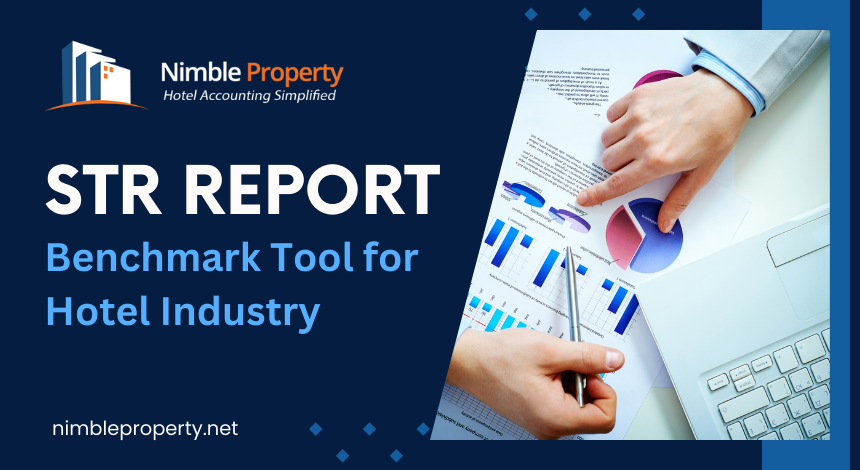Want to learn about your hotel’s performance in the marketplace? Then you don’t have to invest much to understand the competition and growth rate. Business Analytics has taken a new form in modern-day business practice. Providing more data-driven insights to business leaders across the world and enabling them to make quick decisions. Data analytics unfolds the areas of development and relates the performance with the competitors.
In the hospitality industry, Smith Travel Research is a world-renowned hospitality research analytics firm, that provides competitors data that reveals key performance indicators of a property occupancy rate, average daily rate, and revenue per available room.
What are STR Reports?
Smith Travel Research Report is a benchmark tool in the hospitality industry. It provides a report on the property based on market segmentation and key performance indicators. Usually, reports are delivered on a weekly and monthly basis. It considers various factors that impact the hotel business and competitors’ key performance indicators. It provides a score that simplifies the complex analysis part of the business. The reports are released in digital formats, they can be imported into the hotel accounting software. Nimble Property’s user-friendly interface provides easy access to the report.
The reports include the below terminology, if you are aware of these terms, it becomes easy to read the performance of the property, and anyone with minimum financial knowledge can easily understand the metrics of the property.
- Occupancy = Rooms Occupied / Total Rooms. It is expressed in terms of percentage.
- ADR (Average Daily Rate) = Total Revenue / Total Rooms Sold. ADR is the average room rate sold for a given period.
- RevPAR (Revenue per Available Room) = Total Revenue / Total Number of Rooms. RevPAR can also be calculated as ADR x Occupancy.
How to find STR reports for your hotel?
To get the Smith Travel Report, the property owner should provide valid details of the property. They should provide the company’s physical location, rooms sold, vacant rooms, other services, and room categories and the application demands thorough scrutiny of the property’s revenue and non-revenue aspects. It also seeks the category of guests staying in the property, either groups, corporate guests, travelers, or any other.
STR Reports are available on a subscription basis. The pricing is not available online for any category. Subscription is available on a weekly, monthly, and yearly basis, interested candidates can contact them directly.
Why Choose STR Reports?
The hospitality industry lives at the mercy of consumer behavior. Seasonal and unseasonal conditions and various other factors impact the revenue. Above all, dynamic pricing, during the peak season, the average daily rate of the room may go high, and during the unseasonal conditions, properties may not attract guests in expected terms. So, STR reports help revenue managers create some offers or do some activity with pricing to attract more customers.
Smith Travel Research (STR) reports are very helpful in the hotel business because they give a lot of information about how hotels are doing and how the market is changing. Here’s a detailed breakdown of how to understand, use, and leverage STR reports for setting goals, tracking progress, and making informed decisions:
Understanding Smith Travel Research Reports:
Segments Covered:
STR reports cover various segments, such as occupancy rates, average daily rates (ADR), and revenue per available room (RevPAR). Understanding these key metrics is essential for a comprehensive overview of hotel performance.
Market Analysis:
Reports often provide market-level analysis, allowing you to compare your hotel’s performance against the broader market. This includes data on different hotel classes, locations, and competitive sets.
Trend Analysis:
Look for historical data and trend analysis to understand how market conditions have evolved. This can help you identify seasonal patterns and industry cycles.
Geographic Breakdown:
Geographic breakdowns help you analyze performance in specific regions. This is crucial for identifying potential growth areas or understanding challenges in certain markets.
Performance Ratios:
Familiarize yourself with performance ratios like occupancy percentages, ADR, and RevPAR. These ratios provide a quick snapshot of your hotel’s financial health.
Using STR Reports to Set Goals:
Benchmarking:
Use the reports for benchmarking against industry standards and competitors. Set realistic goals based on the performance metrics of top-performing hotels in your market.
Identify Areas for Improvement:
Analyze your hotel’s strengths and weaknesses compared to the market. Set specific goals to improve in areas where your performance lags.
Market Demand:
Assess market demand and adjust your goals accordingly. If the market is growing, consider setting more ambitious targets.
Forecasting:
Utilize historical data and market trends to forecast future performance. Set goals that align with these projections, taking into account external factors like local events and economic conditions.
Using STR Reports to Track Progress:
Regular Monitoring:
Regularly review STR reports to track your hotel’s performance against goals. Identify any deviations and take corrective actions promptly.
Performance Metrics:
Monitor key performance metrics such as occupancy rates, ADR, and RevPAR on an ongoing basis. This provides real-time insights into your hotel’s financial health.
Comparative Analysis:
Continuously compare your hotel’s performance with market benchmarks and adjust strategies accordingly.
Using STR Reports to Make Informed Decisions:
Price Optimization:
Use ADR data to optimize pricing strategies. Adjust room rates based on demand and market conditions to maximize revenue.
Marketing Strategies:
Tailor marketing strategies based on market trends and consumer behavior. Focus on the channels that are most effective in driving bookings.
Investment Decisions:
Assess market demand and performance trends when considering investments or expansions. Make informed decisions about property enhancements or acquisitions.
Competitive Positioning:
Understand your competitive positioning in the market and adjust strategies to gain a competitive edge. This could involve improving services, enhancing amenities, or adjusting pricing strategies.
Conclusion:
In conclusion, understanding, setting goals, tracking progress, and making informed decisions based on Smith Travel Research reports require a comprehensive analysis of the data provided. Regularly revisiting and adapting strategies in response to market dynamics will help optimize your hotel’s performance in a competitive landscape.

